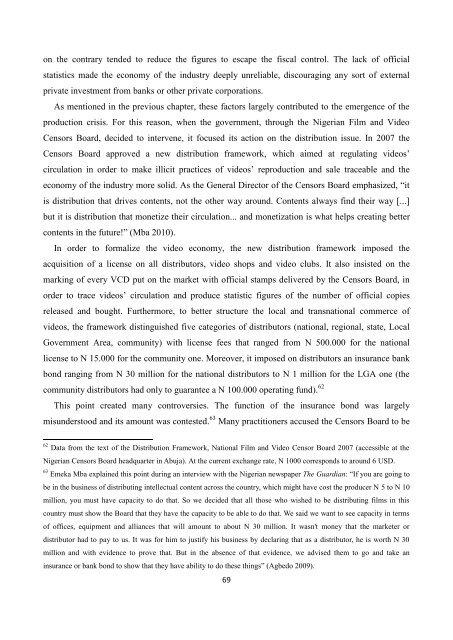You also want an ePaper? Increase the reach of your titles
YUMPU automatically turns print PDFs into web optimized ePapers that Google loves.
on the contrary tended to reduce the figures to escape the fiscal control. The lack of officialstatistics made the economy of the industry deeply unreliable, discouraging any sort of externalprivate investment from banks or other private corporations.As mentioned in the previous chapter, these factors largely contributed to the emergence of theproduction crisis. For this reason, when the government, through the Nigerian Film and VideoCensors Board, decided to intervene, it focused its action on the distribution issue. In 2007 theCensors Board approved a new distribution framework, which aimed at regulating videos’circulation in order to make illicit practices of videos’ reproduction and sale traceable and theeconomy of the industry more solid. As the General Director of the Censors Board emphasized, “itis distribution that drives contents, not the other way around. Contents always find their way [...]but it is distribution that monetize their circulation... and monetization is what helps creating bettercontents in the future!” (Mba 2010).In order to formalize the video economy, the new distribution framework imposed theacquisition of a license on all distributors, video shops and video clubs. It also insisted on themarking of every VCD put on the market with official stamps delivered by the Censors Board, inorder to trace videos’ circulation and produce statistic figures of the number of official copiesreleased and bought. Furthermore, to better structure the local and transnational commerce ofvideos, the framework distinguished five categories of distributors (national, regional, state, LocalGovernment Area, community) with license fees that ranged from N 500.000 for the nationallicense to N 15.000 for the community one. Moreover, it imposed on distributors an insurance bankbond ranging from N 30 million for the national distributors to N 1 million for the LGA one (thecommunity distributors had only to guarantee a N 100.000 operating fund). 62This point created many controversies. The function of the insurance bond was largelymisunderstood and its amount was contested. 63 Many practitioners accused the Censors Board to be62 Data from the text of the Distribution Framework, National Film and Video Censor Board 2007 (accessible at theNigerian Censors Board headquarter in Abuja). At the current exchange rate, N 1000 corresponds to around 6 USD.63 Emeka Mba explained this point during an interview with the Nigerian newspaper The Guardian: “If you are going tobe in the business of distributing intellectual content across the country, which might have cost the producer N 5 to N 10million, you must have capacity to do that. So we decided that all those who wished to be distributing films in thiscountry must show the Board that they have the capacity to be able to do that. We said we want to see capacity in termsof offices, equipment and alliances that will amount to about N 30 million. It wasn't money that the marketer ordistributor had to pay to us. It was for him to justify his business by declaring that as a distributor, he is worth N 30million and with evidence to prove that. But in the absence of that evidence, we advised them to go and take aninsurance or bank bond to show that they have ability to do these things” (Agbedo 2009).69
















